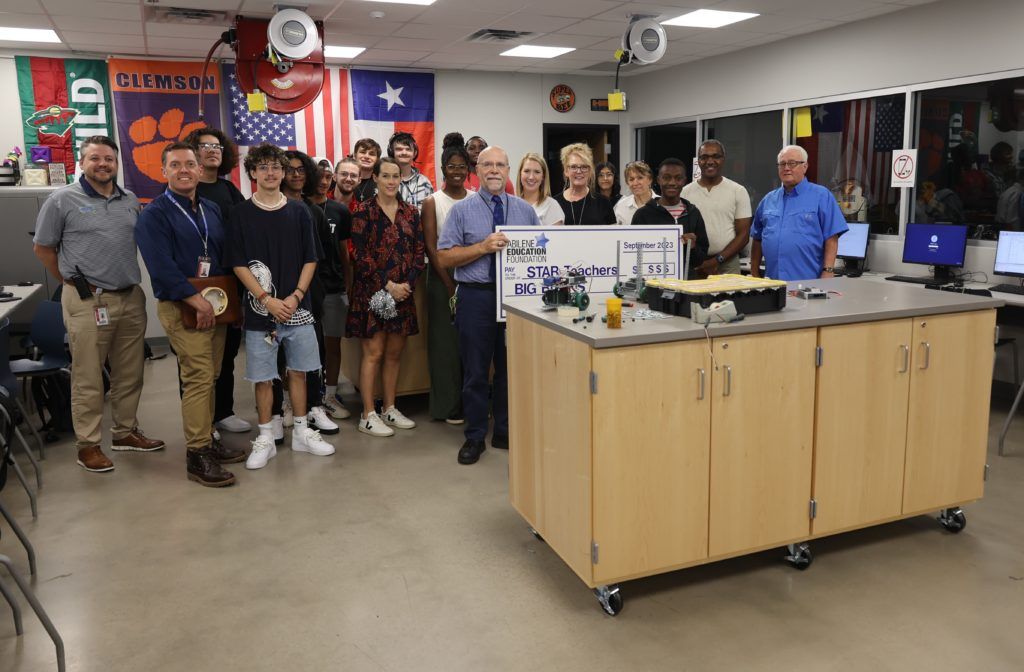Late last month, representatives from the Abilene Education Foundation, its board of directors, and other supporters descended upon 20 campuses across the Abilene ISD, carrying with them the funds necessary to make the lives of teachers a little easier and the learning experience for students better.
Those 20 campuses were stops on the AEF STAR Grant Prize Parade that saw the AEF award 76 grants to more than 120 AISD teachers, totaling more than $79,000. As districts across the country continue to work to close the learning deficit caused by the COVID pandemic of 2020, many of the grants focused on reading, phonics skills, math, and science.
One of the teachers who focused her grant proposal on reading and phonics was Bonham Elementary School second-grade teacher Amanda Martin, who was the recipient of the most money in the district ($2,831.28) because she was awarded two grants: one for “Phonics Games: Making Learning to Read a Piece of Cake” and “Don’t Judge a Book by Its Cover: Decodable Readers Are Engaging and Meaningful.”
Martin said that some of her summer reading – in particular, a book titled Shifting the Balance: 6 Ways to Bring the Science of Reading into the Balanced Literacy Classroom – got her thinking about how to make her classroom more engaging. That’s where the idea of buying decodable readers (books) for her classroom took hold.
Decodable books are simple books written for the beginning reader and contain the specific grapheme-phoneme correspondences (matching a sound to a written representation) students have learned. Decodable books encourage children to sound out words using decoding strategies rather than guessing from pictures or predicting from other cues.
In addition to the decodable readers, Martin will use almost half of her grant money on phonics games to help young readers hone their skills.
“When teachers receive AEF STAR Grant money, it gives our students opportunities not only to learn but be engaged and take ownership of their learning,” Martin said. “Decodable readers and phonics activities won’t just be for my struggling students, but also some of my most gifted students. These awards will allow us to differentiate and meet all my learners’ needs in my classroom.”
If they can do that, she believes that will spur a continued interest in reading.
“What I hope is that because my students will have access to the decodable readers and phonics activities that they’ll practice with them daily, and we’ll see growth in their reading MAP scores because of the access they’ll have to decodable readers and reading activities,” Martin said. “When children read better, they imagine more deeply, develop more vocabulary, and engage in critical thinking. My goal with these books and readers is to help nurture the love of reading for the rest of their lives.”

Across town, ATEMS robotics and engineering instructor Larry Haney was one of eight AISD teachers awarded the maximum grant of $1,500 for his project titled “To the Moon and Beyond: The Challenger Learning Center, Space Center Houston, NASA.”
As easily deciphered from the project’s title, Haney will take 24 engineering students to NASA in Johnson City, Texas, next spring to dive deeply into the how-tos of manned and unmanned space flight. On their way to Houston, the students will stop at the Challenger Center in Waco, created by donations after the Challenger exploded in January 1986.
“Space has always been a hotbed for engineering, so I want to take some of our students to the Johnson Space Center, where they’ll be able to see, touch, and ask questions about the engineering used for space flight. The stop in Waco will allow our students to be part of a simulated mission to the moon and be in Mission Control for the moon simulation.”
Haney said the trip’s primary purpose is to give his students a better understanding of what an engineering career looks like, along with some other side benefits.
“They need to understand the expectations that go with a career in engineering, as well as the excitement they can experience with a career in engineering or another STEM career,” he said. “I want them to experience more real-world career opportunities to better prepare them for life after high school. I also find it interesting how many of our students have never been to NASA. I hope this experience will help grow their world and that it will have a large impact on their future.”

